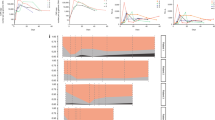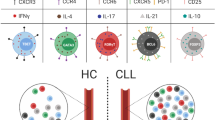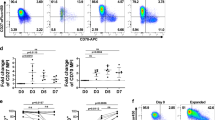Abstract
Excessive activated T-cell proliferation was observed in vivo in one patient after an anti-CD19-chimeric antigen receptor (CAR) T-cell infusion. The patient, who had chemotherapy refractory and CD19+ diffuse large B-cell lymphoma (DLBCL), received an anti-CD19 CAR T-cell infusion following conditioning chemotherapy (fludarabine/cyclophosphamide). The lymphocyte count in the peripheral blood (PB) increased to 77 × 109/L on day 13 post infusion, and the proportion of CD8+ actived T cells was 93.06% of the lymphocytes. Then, the patient suffered from fever and hypoxaemia. Significant increases in serum cytokine, lactate dehydrogenase, aspartate aminotransferase (AST), alanine transaminase (ALT), and glutamic-oxalacetic transaminase (γ-GT) levels were observed. A high-throughput sequencing analysis for T-cell receptors (TCRs) and whole-genome sequencing were used to explore the mechanisms underlying this excessive T-cell proliferation. TCR diversity was demonstrated, but no special gene mutation was found. The patient was found to be infected with the John Cunningham polyomavirus (JCV). It cannot be ruled out the bystander activation pathway induced by JCV infections related the excessive activated T-cell proliferation. Although the clinical and laboratory data do not fully explain the reason for excessive T-cell proliferation after the anti-CD19 CAR T-cell infusion, the risk of this type of toxicity should be emphasized. This study was registered at www.clinicaltrials.gov as NCT01864889.
This is a preview of subscription content, access via your institution
Access options
Subscribe to this journal
Receive 12 print issues and online access
$259.00 per year
only $21.58 per issue
Buy this article
- Purchase on Springer Link
- Instant access to full article PDF
Prices may be subject to local taxes which are calculated during checkout





Similar content being viewed by others
References
Levine BL, Miskin J, Wonnacott K, Keir C. Global manufacturing of CAR T cell therapy. Mol Ther Methods Clin Dev. 2017;4:92–101.
Ruella M, June CH. Chimeric antigen receptor T cells for B cell neoplasms: choose the right CAR for you. Curr Hematol Malig Rep. 2016;11:368–84.
Oluwole OO, Davila ML. At the bedside: clinical review of chimeric antigen receptor (CAR) T cell therapy for B cell malignancies. J Leukoc Biol. 2016;100:1265–72.
Ramos CA, Heslop HE, Brenner MK. CAR-T cell therapy for lymphoma. Annu Rev Med. 2016;67:165–83.
Dai HR, Zhang WY, Li SX, Han QW, Guo YL, Zhang Y, et al. Tolerance and efficacy of autologous or donor-derived T cells expressing CD19 chimeric antigen receptors in adult B-ALL with extramedullary leukemia. Oncoimmunology. 2015;4:e1027469.
Wang Y, Zhang WY, Han QW, Liu Y, Dai HR, Guo YL, et al. Effective response and delayed toxicities of refractory advanced diffuse large B-cell lymphoma treated by CD20-directed chimeric antigen receptor-modified T cells. Clin Immunol. 2014;155:160–75.
Cai B, Guo M, Wang Y, Zhang Y, Yang J, Guo Y, et al. Co-infusion of haplo-identical CD19-chimeric antigen receptor T cells and stem cells achieved full donor engraftment in refractory acute lymphoblastic leukemia. J Hematol Oncol. 2016;9:131.
Davila ML, Riviere I, Wang X, Bartido S, Park J, Curran K, et al. Efficacy and toxicity management of 19-28z CAR T cell therapy in B cell acute lymphoblastic leukemia. Sci Transl Med. 2014;6:224ra225.
Maude SL, Barrett D, Teachey DT, Grupp SA. Managing cytokine release syndrome associated with novel T cell-engaging therapies. Cancer J. 2014;20:119–22.
Fesnak AD, June CH, Levine BL. Engineered T cells: the promise and challenges of cancer immunotherapy. Nat Rev Cancer. 2016;16:566–81.
Cherkassky L, Morello A, Villena-Vargas J, Feng Y, Dimitrov DS, Jones DR, et al. Human CAR T cells with cell-intrinsic PD-1 checkpoint blockade resist tumor-mediated inhibition. J Clin Invest. 2016;126:3130–44.
Ford ML, Koehn BH, Wagener ME, Jiang W, Gangappa S, Pearson TC, et al. Antigen-specific precursor frequency impacts T cell proliferation, differentiation, and requirement for costimulation. J Exp Med. 2007;204:299–309.
Varmus HE, Quintrell N, Ortiz S. Retroviruses as mutagens: insertion and excision of a nontransforming provirus alter expression of a resident transforming provirus. Cell. 1981;25:23–36.
Hacein-Bey-Abina S, Von Kalle C, Schmidt M, McCormack MP, Wulffraat N, Leboulch P, et al. LMO2-associated clonal T cell proliferation in two patients after gene therapy for SCID-X1. Science. 2003;302:415–9.
Mani J, Wang L, Huckelhoven AG, Schmitt A, Gedvilaite A, Jin N, et al. Definition and characterization of novel HLA-*A02-restricted CD8+ T cell epitopes derived from JCV polyomavirus with clinical relevance. Oncotarget. 2017;8:2485–2500.
Hsu C, Jones SA, Cohen CJ, Zheng Z, Kerstann K, Zhou J, et al. Cytokine-independent growth and clonal expansion of a primary human CD8+T-cell clone following retroviral transduction with the IL-15 gene. Blood. 2007;109:5168–77.
Mani J, Jin N, Schmitt M. Cellular immunotherapy for patients with reactivation of JC and BK polyomaviruses after transplantation. Cytotherapy. 2014;16:1325–35.
Tough DF, Borrow P, Sprent J. Induction of bystander T cell proliferation by viruses and type I interferon in vivo. Science. 1996;272:1947–50.
Andreasen SO, Christensen JP, Marker O, Thomsen AR. Virus-induced non-specific signals cause cell cycle progression of primed CD8 (+) T cells but do not induce cell differentiation. Int Immunol. 1999;11:1463–73.
Nie J, Zhang Y, Li X, Chen M, Liu C, Han W. DNA demethylating agent decitabine broadens the peripheral T cell receptor repertoire. Oncotarget. 2016;7:37882–92.
Acknowledgements
This study was supported by grants from the National Natural Science Foundation of China (No. 81402566, 81472612), the grants the Science and Technology Planning Project of Beijing City (No. Z151100003915076 to W.-D.H.) and the National Key Research and Development Program of China (No. 2016YFC1303501 and 2016YFC1303504 to W.-D.H.).
Author contributions
W.-Y.Z., Y.L. and Z.-Q.W. designed and performed the in vitro experiment, analyzed the data, and wrote the manuscript; J.N., G.Y.-L. and D.H.-R. performed the in vitro experiments; Q.-M.Y. and W.C.-M. ensured compliance with regulatory requirements for the clinical trial; Y.W. supervised the manufacture of cells in infusion; W.-D.H. enroled patients in the study, analyzed the data, and wrote and reviewed the manuscript.
Author information
Authors and Affiliations
Corresponding authors
Ethics declarations
Conflict of interest
The authors declare that they have no conflict of interest.
Rights and permissions
About this article
Cite this article
Zhang, Wy., Liu, Y., Wang, Y. et al. Excessive activated T-cell proliferation after anti-CD19 CAR T-cell therapy. Gene Ther 25, 198–204 (2018). https://doi.org/10.1038/s41434-017-0001-8
Received:
Revised:
Accepted:
Published:
Issue Date:
DOI: https://doi.org/10.1038/s41434-017-0001-8
This article is cited by
-
Visualizing CAR-T cell Immunotherapy Using 3 Tesla Fluorine-19 MRI
Molecular Imaging and Biology (2022)
-
Programming CAR T cells to enhance anti-tumor efficacy through remodeling of the immune system
Frontiers of Medicine (2020)



